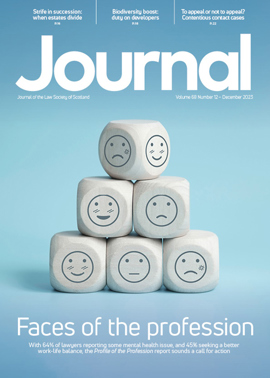Book reviews
As the author notes in his preface to this text, it is over six years since the previous edition of Family Law. With the advent of the Scottish Parliament there have been numerous changes to Scots family law and, although, as Professor Thomson points out, a Family Law Reform Bill is expected, it seems that it will not occur during the lifetime of this Parliament. He has therefore taken advantage of this postponement to update his popular text, providing students and practitioners with an up-to-date guide through the most recent developments in the area. The structure of the book remains the same, which is always an advantage for busy practitioners who come to rely on the familiarity of a text’s layout. They will also be glad to know that they can rely upon the author’s renowned clarity and willingness to be critical, as in his discussion of Stott v. Stott 1987 GWD 17-645.
Throughout the text there are frequent references to potential legislation which the Scottish Executive has in many cases indicated will be enacted. The author, as a Scottish Law Commissioner, is particularly well placed to comment on the status of Law Commission recommendations and the likelihood of pursuant legislation. Some of the issues raised as ripe for reform include the criminalisation of physical punishment to a child under 3 years and the express abolition of the concept of illegitimacy.
The enactment of the Human Rights Act 1998 and its pervasive impact on Scots law is addressed across a range of topics. These include the various procedural issues that arise in relation to the compulsory care of children under the Children (Scotland) Act 1995, when the Social Work Department of a Local Authority may have to intervene either to remove the child for his or her own protection from an abusive family, or to detain a child when his or her behaviour justifies such action. The ramifications of Articles 5, 6 and 8 of the EHCR are covered in some detail. The Human Rights dimension is also discussed in relation to adoption, abortion and capacity to marriage for transsexuals, a matter that is under legislative review since the decision in Goodwin v United Kingdom in July 2002 reported in the press just in time for inclusion in this book.
Recent legislation discussed includes the Mortgage Rights (Scotland) Act 2001 which provides extended tenure to a debtor, spouse, cohabitee of either sex in the event of default on mortgage payments. The Protection from Harassment Act 1997 is given a very brief mention, and arguably deserves more discussion, particularly in its relationship and interplay with orders under the Matrimonial Homes (Family Protection) (Scotland) Act 1981. The Welfare Reform & Pensions Act 1999 is given more extensive treatment as its impact on pension sharing orders under the Family Law (Scotland) Act 1995 on divorce is significant.
Once again Professor Thomson has produced a commendably lucid and accessible text with a sufficiently detailed indexing and referencing system to allow points to be followed up where necessary. He has performed a most valuable service for students and practitioners alike, and despite strong competition from a number of sources, this book comes highly recommended.
Fiona Raitt, University of Dundee
In this issue
- Obituary: John Downie Herd
- Obituary: Bill Liddell
- The tyranny of fact pleadings
- Bringing human rights to the prison population
- Pragmatic solutions to udal law
- Take care framing pleas in law
- Everything but the kitchen sink?
- Serving solicitors in time of need
- Scottish Solicitors’ Discipline Tribunal
- Website reviews
- Rough guide to controlling critical dates
- Europe
- Plain speaking
- Book reviews






